Would Watch Companies Really Just Go on the Internet and Tell Lies?
Please don't sue me for libel
The Precursor
I probably should have consulted legal counsel before publishing this week’s newsletter. Please, Switzerland - I left my biases at the door and tried to be as factual as possible. It’s a horological saga that’s too interesting not to write about, and if I get disappeared by the Swiss cartel, I’m happy for this newsletter to stand as my legacy.
On a more positive note, I included a watch I don’t yet own but certainly hope to one day. Maybe writing nice articles about it was my subconscious attempt at generating enough karma to win the next Lotec Lottery. Is that how karma works?
Credor GCBK987 “Pacific” Chronograph
Twenty years ago, a shadow loomed over the watchmaking world. You’ve presumably heard of ETA - historically, they have manufactured movements for, well… basically everyone. As a result, When ETA announced it wasn’t going to supply movements to companies outside of the Swatch Group, it was seen as an extinction-level event for some major players in the Swiss watch market.
Brands like Omega, Longines, Breguet, and Hamilton, were all part of the aforementioned Swiss conglomerate Swatch Group, so could continue to sit at the cool kids' table and use ETA’s movements. But for others, the situation looked dire. Some of the Swiss brands affected by the sudden news included:
Breitling
Tudor
Tag Heuer
Hublot
IWC
Panerai
Sinn
Oris
With their movements potentially disappearing overnight, where could they turn?
Sellita, one of ETA’s longest-standing parts suppliers, pulled off a particularly devilish move - using everything it had learned from working with ETA to create ETA alternatives, or clone movements. This turned out to be a great option for several of the brands listed above. But some, perhaps traumatised by already being rug-pulled by one movement supplier, decided to go in-house.
TAG Heuer was one such brand. And in 2009, it proudly unveiled the Calibre 1887, its first fully in-house movement. The watch world took note. This was a huge moment - not just for TAG but for all watchmakers. If a 6-9-12 automatic chronograph could be built fully in-house, in under three years, by a company that had never made its own movements before, surely there was hope for everyone?
The dark cloud ETA had cast over Switzerland was beginning to lift.
But there was a problem. When TAG Heuer said it was designed “in-house”, it turned out they weren’t actually talking about their house… they were talking about Seiko’s house. Awkward.
To be clear, this wasn’t corporate espionage - TAG Heuer legally bought the movement designs from Seiko - but people felt they were trying to pull a fast one on their customers. TAG came out and said they tweaked some of the internal parts, but you can’t just change the wording of your friend’s homework and then claim it as your own, can you?
The watch on offer today has the dubious honour of being powered by the Seiko 6S calibre - the same one TAG Heuer tried to pass off as being their “in-house” movement. It features a 12-hour chronograph timer, as well as a power reserve indicator at 3 o’clock. The design is an interesting mix of sunken subdials and raised numerals, and, true to its Pacific roots, the central dial is textured like rough sea waves.
The GCBK987 “Pacific Chronograph” is now available to buy on our website.
In great condition overall. No marks of any noticeable significance. Box and papers.
The ETA Epilogue
In the end, no one needed to immediately panic, as ETA’s plan to stop supplying movements to non-Swatch Group brands was blocked by COMCO, Switzerland’s anti-monopoly regulator. After years of investigation, COMCO ruled in 2013 that ETA had to continue supplying third parties until 2020. ETA reluctantly agreed.
Then, in 2019, a complete reversal happened. COMCO banned ETA from selling movements to anyone other than pre-existing customers. The reason? ETA’s dominance had allegedly become “anti-competitive”, and the regulators hoped the ban would allow other movement makers to flourish. ETA appealed, and in 2020, COMCO lifted the ban, allowing them to start selling movements to third parties again.
Did COMCO and ETA just switch sides? Yep.
I can’t quite get my head around the absurdity of ETA successfully appealing a COMCO-enforced ban in the same year ETA had originally sought permission from COMCO to stop supplying movements to anyone. I give up. There’s far less drama in the Japanese watch world.
Otsuka Lotec “Wandering Hours” No. 5 Kai
The timing of the No. 5 Kai’s release feels like Jiro Katayama’s well-deserved victory lap. Just months after his No. 6 watch won the GPHG Challenge Award in Switzerland, the latest offering from Katayama’s humble Japanese watchmaking studio is beginning to reach the wrists of those fortunate enough to have won the Lotec Lottery. And for those who haven’t already seen the Kai, let me needlessly set your expectations sky-high by saying this is his best work yet.
Kai means revision or upgrade, because this isn’t the first No. 5 Lotec Katayama has released. The original No. 5 debuted in 2012 and shares obvious design ties with the Kai. While their execution differs, they both achieve their Wandering Hours through similar technical means.
There are various movement upgrades between the two, and the one Katayama seems most excited about might not be the most obvious. The smooth and long-lasting rotation of the second disc is aided by the world’s smallest diameter ball bearing. At just 1.49mm wide, it literally earned a Guinness World Record in 2015 - and remarkably remains unbeaten to this day.
I’ll admit, it’s impressively small. Katayama has made it clear that not only were these tiny ball bearings physically crucial to the build’s success, but he also wanted to show them off to the world. In his own words, “ball bearings this small are not made in Switzerland, so it is a technology that can only be achieved in Japan, and the Kai is truly an all-Japan watch.”
You tell ‘em, King.
Not only are the ball bearings impressively compact, but the watch itself isn’t as thick as you might expect from such a complication. It’s 7.6mm tall without the box crystal and 12.2mm with it—putting it in the same thickness range as Seiko’s Cocktail Collection. Not bad for such a vertically stacked movement.
I often hear the sentiment that “it’s just a Miyota movement”, but that feels distinctly misguided. Yes, the base movement is a Miyota skeleton made by Citizen, but the reason for its usage isn’t technical.
You don’t need to be a trained watchmaker to see that the Wandering Hour complication module, made entirely in-house by Katayama, is far more complex than the base elements of a Miyota. Given that Katayama and his small team of three engineers can only produce around 200 watches each year - split across all Lotec models and prototypes - it would be almost irresponsible to waste time building the base movement from scratch.
But don’t misunderstand Katayama’s ambitions. He’s made it clear that he intends to expand his team in 2026, and one of their first priorities will be developing a fully in-house movement. Until then, with production as limited as it currently is, the movement “trade-off” seems more than justified from a consumer standpoint.
Models 1 to 4 were never publicly sold, and were simply given as gifts to friends and family. Models 5 and above are sold through a Japan-only lottery system. The first lottery results for the Kai were announced last week - sadly, I didn’t win (nor did my wife or the three work colleagues who kindly signed up on my behalf). So I don’t have a Kai for sale, but just like the Lotec No. 6, I’ll be scouring the Japanese watch forums for anyone looking to sell theirs on consignment. Watch this space.
ISOChrono scored an in-person interview with Katayama earlier this year. It’s a great piece, and Katayama is an open book - I strongly recommend giving it a watch if you’d like to learn more about the man behind the award-winning studio.
Custom Made “Original Black” Vinyl
A retro-inspired LP design full of vintage touches. The sleek black dial features heavily textured grooves and a needle-style minute hand, all housed in a top hat crystal case.
This is a reworked custom watch I last assembled in 2024. The hands have all received a welcome upgrade, and while the overall design is fairly niche, I’m confident it will strike the right chord with the right people.
I’ve only put together a handful of these, plus a one-of-one golden variant, so visit the website below or get in touch if you’re interested before I list them in all the usual places next week.
The “Original Black” Vinyl is available to buy on our website.
In brand new, unworn condition.
Credor “His & Hers” 2F70 Pair
Why stop at matching outfits? Not a watch I’ll be writing about in full today, as I covered it before, but I wanted to highlight that I’m offering a His & Hers pair today, rather than a singular 2F70-5130. According to the papers, the pair was purchased from the Takamatsu Branch of a Mitsukoshi, a high-end Department store in Japan, in December 1985.
Given they started their life as a pair, I would like to keep them as a pair, so I won’t be taking offers for them individually.
The Credor “His & Hers” 2F70 Pair is available to buy on our website.
In very good condition overall. Minor signs of age can be seen on the cases and bracelets, but the dials and crystals are in great shape. Box and papers. Sold as a pair.
Campanola “Mother of Pearl” BU0020-62A
An interesting example of variance caused by hand assembly. I’m not going to cover this watch in full today, as I recently covered the Tenmanboshi, or gold version of it, so please click here if you missed it.
However, I’d like to briefly highlight the fascinating results of Campanola’s dedication to hand-finishing.
While you might assume the Mother of Pearl is scattered randomly across the Urushi lacquer dial, the reality, according to Campanola, is far more deliberate. Campanola’s watchmakers select each individual piece based on size and colour, then have the freedom to choose its placement with no specific guidance beyond “create a view from space as seen from the porthole of a spaceship”.
The dial on the left is the BU0020-62A on offer today, and the dial on the right is a previously sold BU0020-62A. Sometimes less is more, and sometimes more is more - I’m not here to judge which is “better”, as there’s no right answer, but the difference between the two is so extreme that I felt it was interesting enough to share.
The Campanola BU0020-62A is available to buy on our website.
In very good condition overall. Hairlines on the top of the bezel are visible in certain lighting, but nothing you’d notice on the wrist. Full box and papers.
Don’t forget to follow my Instagram to see all of the watches above in full cinematic glory next week.





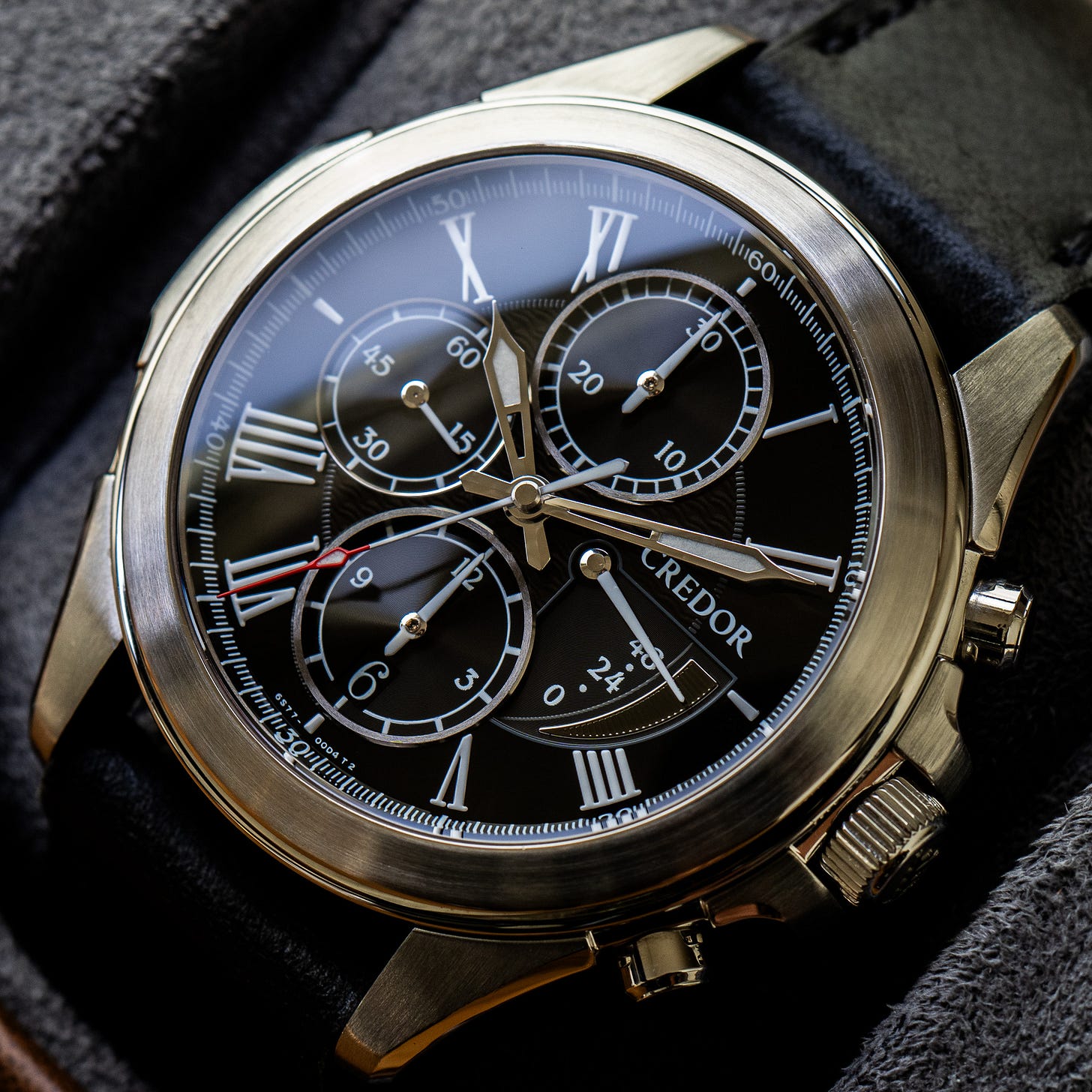




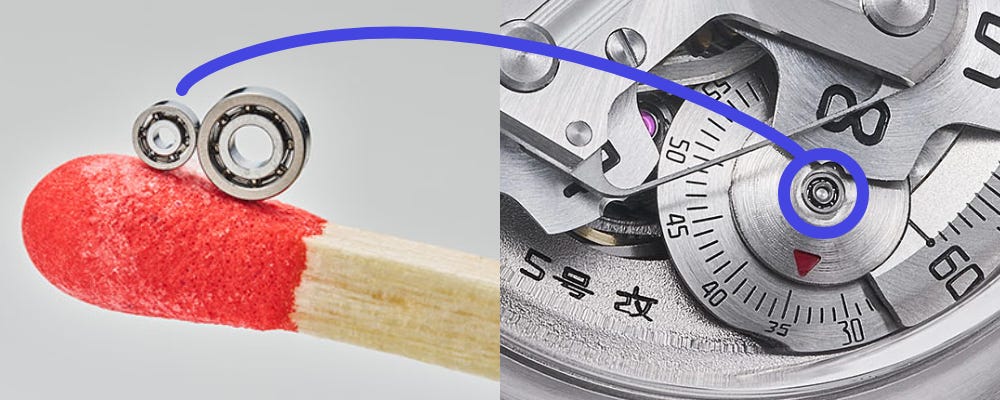

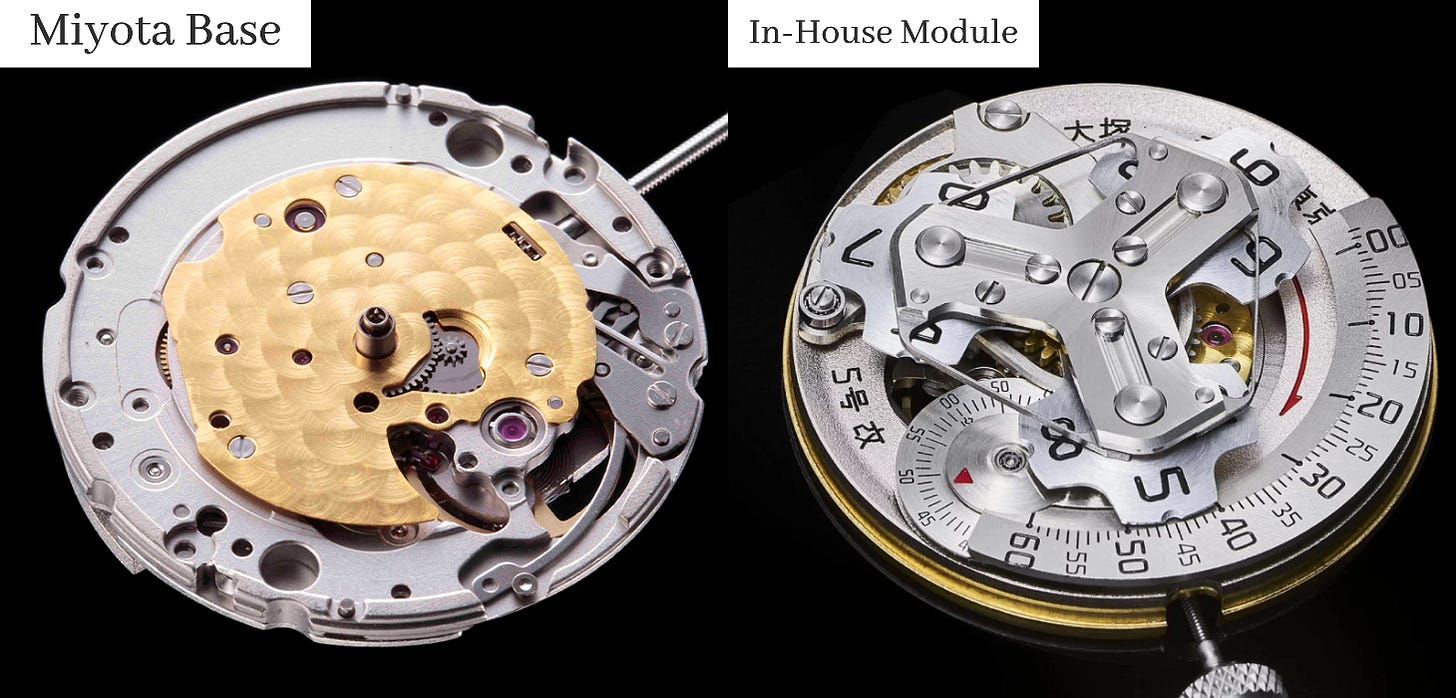


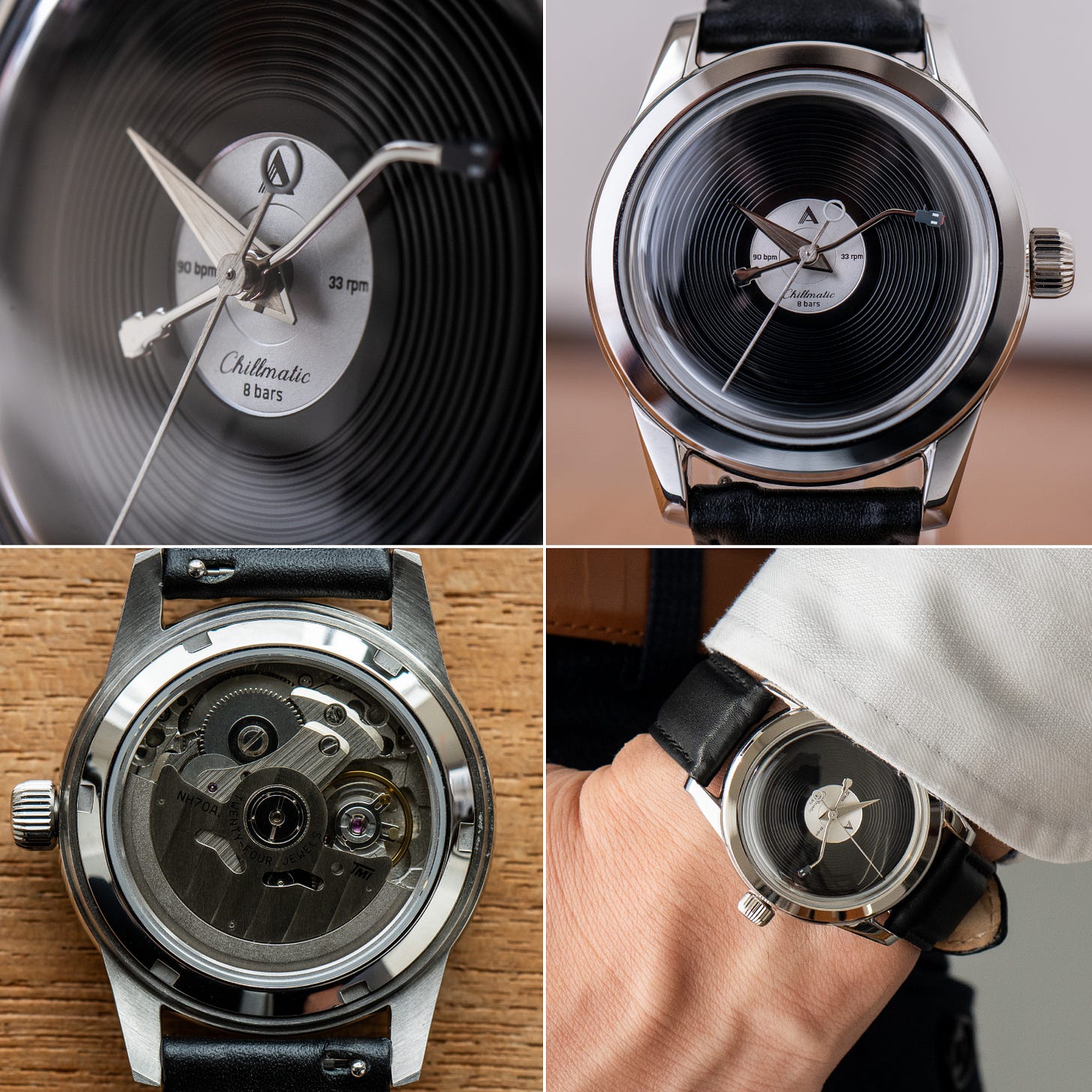

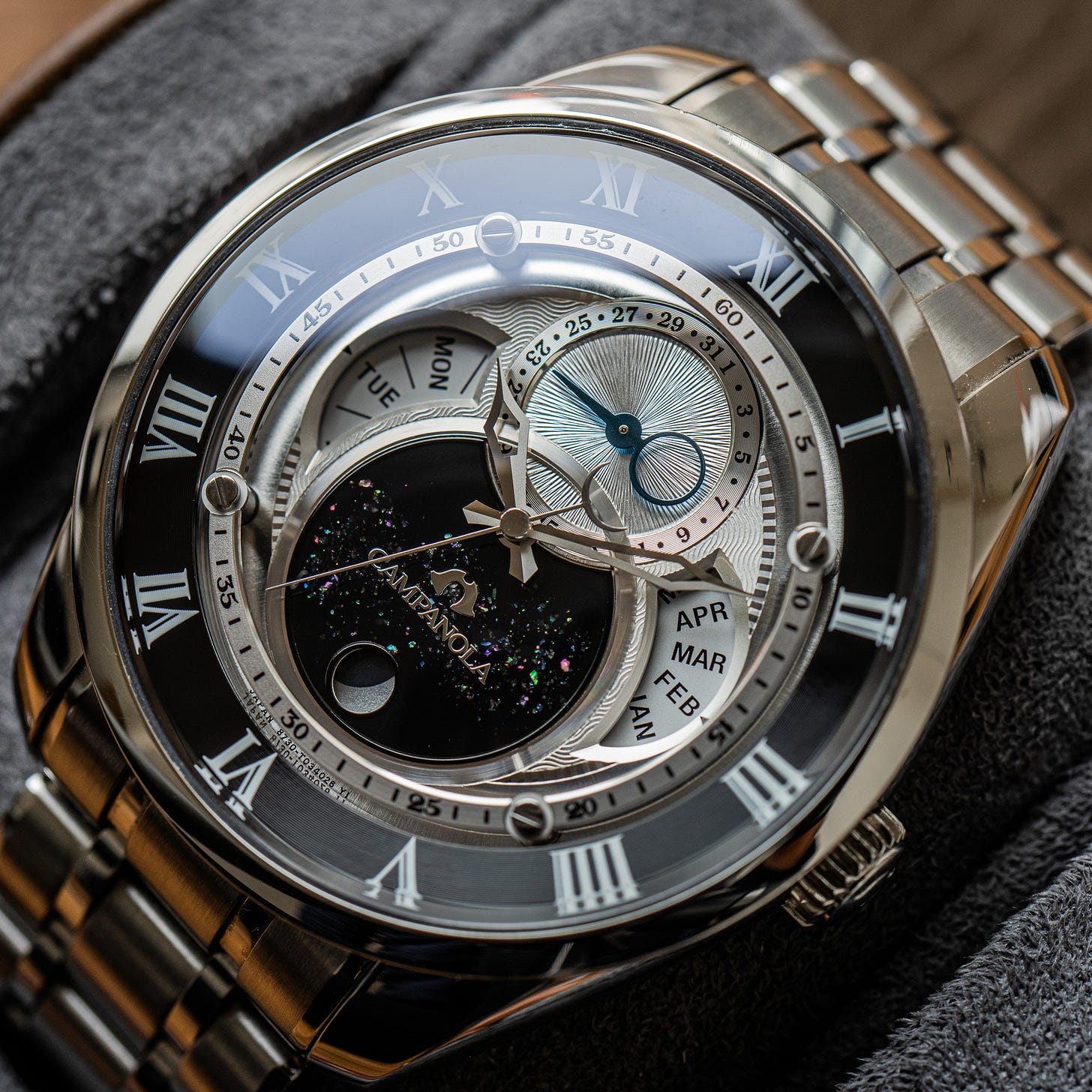

I've tried three times to get a Lotec, but no luck. I won't give up.